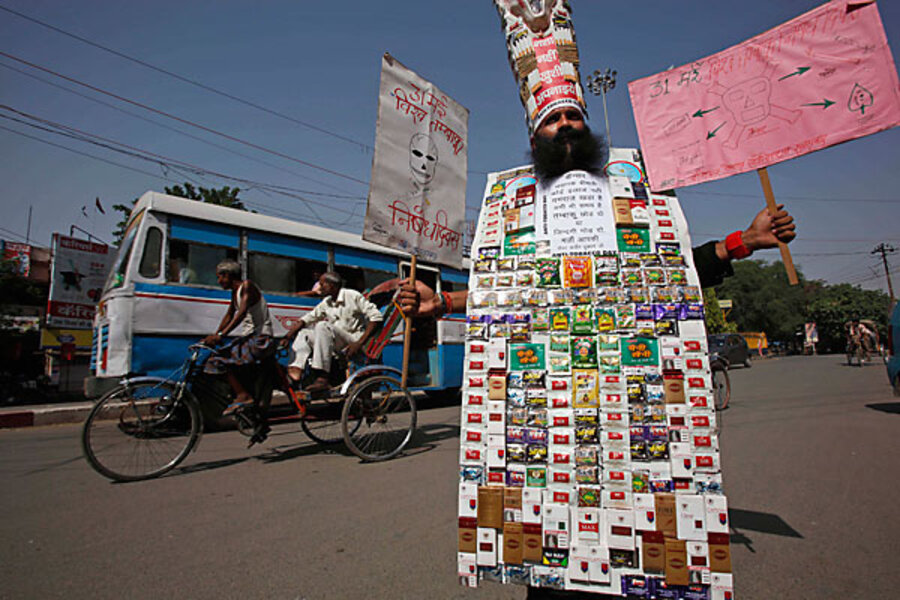World No Tobacco Day: Which countries smoke the most?
Loading...
| Boston
Memorial Day means picnics and parades. That means crowds, and crowds invariably mean cigarette smokers.
So you may not take comfort that there are 5 million annual tobacco-related deaths worldwide, according to the World Health Organization (WHO).
That toll is expected to rise to 8 million annual tobacco-related deaths by 2030, according to the WHO report released today to coincide with World No Tobacco Day, which is held annually on May 31.
“Exposure levels are up,” says Samira Asma, chief of the Global Tobacco Control Branch at the Centers for Disease Control and Prevention (CDC). “If there is no action, I think we are going to see a grim future.”
The WHO created World No Tobacco Day in 1987 to draw global attention to tobacco use and the preventable death and disease it causes.
Not only is tobacco use increasing, according to the WHO report, but it's increasing, especially among women. Although women account for only about 20 percent of the world's smokers, the WHO found female smoking rates on the rise, “suggesting that tobacco companies might be targeting this group."
“Historically, the tobacco industry has taken advantage of increasingly liberalized social attitudes toward women and increased economic empowerment of women to aggressively market and sell its products. In the absence of effective tobacco control policies, this pattern might repeat itself in low- and middle-income countries, resulting in a rise in tobacco use and tobacco-related disease and death,” according to the report.
The tobacco industry spends tens of billions of dollars annually on direct and indirect advertising, according to the WHO. Cigarette use among Americans, after declining for decades, has remained virtually unchanged for five straight years, the CDC announced in 2009, with nearly 21 percent of the US's adult population being regular smokers.
The greatest increases in smoking in recent years are in poor and developing countries. According to the WHO, only 26 countries have implemented comprehensive bans on direct and indirect tobacco advertising, and many do not have high levels of compliance.
The WHO's MPOWER strategy aims to mitigate the impact. MPOWER stands for: monitor tobacco use; protect people from tobacco smoke; offer help to quit tobacco use; warn about the dangers of tobacco; enforce bans on tobacco advertising; and raise taxes on tobacco products.
It's been notable in Brazil, which has given high priority and commitment to combating the tobacco epidemic and has implemented smoke-free policies in Rio de Janeiro, Salvador, and São Paulo.
What nations smoke the most?
The WHO says the following countries have the highest percentages of daily smokers:
- Lebanon, 58.8
- Guinea, 57.6
- Nauru, 48.2
- Kiribati, 42
- Bulgaria, 39.7
- Lesotho, 39.3
- Tuvalu, 37.9
- Ukraine, 37.4
- Andorra, 36
- Laos, 35.7
Madagascar had the lowest reported rate, at 0.1 percent of the adult population.
While this is the most recent global data, it is self-reported by each country. Not all countries report data, and the data available does not all come from the same year (Lebanon, for example, last reported data in 2002, and Guinea last reported in 1998).
Data on worldwide tobacco use remains limited. The WHO in 2007 launched the Global Adult Tobacco Survey to measure tobacco use. Thus, far, only 14 countries have submitted data.
Turkey and Syria have recently enacted no-smoking legislation, and Egypt has passed legislation to increase taxation, signaling progress in the Middle East on reducing tobacco use. But it will take time before a dent – if any – is seen in tobacco use, says Sara Mirza, an epidemiologist at the Global Tobacco Control Branch of CDC’s Office on Smoking and Health.
“We did not have a consistent way of measuring tobacco control measures in countries,” says Dr. Mirza. “This is the first time we have cross-country data," which will allow the WHO and CDC to better analyze smoking trends worldwide.
RELATED:





